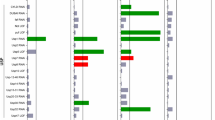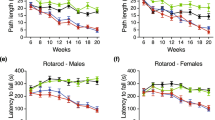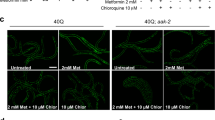Abstract
Huntington's disease is a fatal neurodegenerative disorder caused by a CAG repeat expansion encoding a polyglutamine tract in the huntingtin (Htt) protein1. Here we report a genome-wide overexpression suppressor screen in which we identified 317 ORFs that ameliorate the toxicity of a mutant Htt fragment in yeast and that have roles in diverse cellular processes, including mitochondrial import and copper metabolism. Two of these suppressors encode glutathione peroxidases (GPxs), which are conserved antioxidant enzymes that catalyze the reduction of hydrogen peroxide and lipid hydroperoxides2. Using genetic and pharmacological approaches in yeast, mammalian cells and Drosophila, we found that GPx activity robustly ameliorates Huntington's disease–relevant metrics and is more protective than other antioxidant approaches tested here. Notably, we found that GPx activity, unlike many antioxidant treatments, does not inhibit autophagy, which is an important mechanism for clearing mutant Htt. Because previous clinical trials have indicated that GPx mimetics are well tolerated in humans, this study may have important implications for treating Huntington's disease.
This is a preview of subscription content, access via your institution
Access options
Subscribe to this journal
Receive 12 print issues and online access
$209.00 per year
only $17.42 per issue
Buy this article
- Purchase on Springer Link
- Instant access to full article PDF
Prices may be subject to local taxes which are calculated during checkout




Similar content being viewed by others
References
The Huntington's Disease Collaborative Research Group. A novel gene containing a trinucleotide repeat that is expanded and unstable on Huntington's disease chromosomes. Cell 72, 971–983 (1993).
Lei, X.G., Cheng, W.H. & McClung, J.P. Metabolic regulation and function of glutathione peroxidase-1. Annu. Rev. Nutr. 27, 41–61 (2007).
Giorgini, F., Guidetti, P., Nguyen, Q., Bennett, S.C. & Muchowski, P.J. A genomic screen in yeast implicates kynurenine 3-monooxygenase as a therapeutic target for Huntington disease. Nat. Genet. 37, 526–531 (2005).
Giorgini, F. & Muchowski, P.J. Screening for genetic modifiers of amyloid toxicity in yeast. Methods Enzymol. 412, 201–222 (2006).
Bodner, R.A. et al. Pharmacological promotion of inclusion formation: a therapeutic approach for Huntington's and Parkinson's diseases. Proc. Natl. Acad. Sci. USA 103, 4246–4251 (2006).
Willingham, S., Outeiro, T.F., DeVit, M.J., Lindquist, S.L. & Muchowski, P.J. Yeast genes that enhance the toxicity of a mutant huntingtin fragment or α-synuclein. Science 302, 1769–1772 (2003).
Gelperin, D.M. et al. Biochemical and genetic analysis of the yeast proteome with a movable ORF collection. Genes Dev. 19, 2816–2826 (2005).
Meriin, A.B. et al. Huntington toxicity in yeast model depends on polyglutamine aggregation mediated by a prion-like protein Rnq1. J. Cell Biol. 157, 997–1004 (2002).
Huang da, W., Sherman, B.T. & Lempicki, R.A. Systematic and integrative analysis of large gene lists using DAVID bioinformatics resources. Nat. Protoc. 4, 44–57 (2009).
Bolender, N., Sickmann, A., Wagner, R., Meisinger, C. & Pfanner, N. Multiple pathways for sorting mitochondrial precursor proteins. EMBO Rep. 9, 42–49 (2008).
Devi, L., Prabhu, B.M., Galati, D.F., Avadhani, N.G. & Anandatheerthavarada, H.K. Accumulation of amyloid precursor protein in the mitochondrial import channels of human Alzheimer's disease brain is associated with mitochondrial dysfunction. J. Neurosci. 26, 9057–9068 (2006).
Breitkreutz, B.J., Stark, C. & Tyers, M. Osprey: a network visualization system. Genome Biol. 4, R22 (2003).
Chatr-Aryamontri, A. et al. The BioGRID interaction database: 2013 update. Nucleic Acids Res. 41, D816–D823 (2013).
Schwartz, E.K. et al. Mus81-mms4 functions as a single heterodimer to cleave nicked intermediates in recombinational DNA repair. Mol. Cell Biol. 32, 3065–3080 (2012).
Campesan, S. et al. The kynurenine pathway modulates neurodegeneration in a Drosophila model of Huntington's disease. Curr. Biol. 21, 961–966 (2011).
Zwilling, D. et al. Kynurenine 3-monooxygenase inhibition in blood ameliorates neurodegeneration. Cell 145, 863–874 (2011).
Li, X. et al. Aberrant Rab11-dependent trafficking of the neuronal glutamate transporter EAAC1 causes oxidative stress and cell death in Huntington's disease. J. Neurosci. 30, 4552–4561 (2010).
Stack, E.C., Matson, W.R. & Ferrante, R.J. Evidence of oxidant damage in Huntington's disease: translational strategies using antioxidants. Ann. NY Acad. Sci. 1147, 79–92 (2008).
Klepac, N. et al. Oxidative stress parameters in plasma of Huntington's disease patients, asymptomatic Huntington's disease gene carriers and healthy subjects: a cross-sectional study. J. Neurol. 254, 1676–1683 (2007).
Kish, S.J., Morito, C.L. & Hornykiewicz, O. Brain glutathione peroxidase in neurodegenerative disorders. Neurochem. Pathol. 4, 23–28 (1986).
Pérez-Severiano, F. et al. Increased formation of reactive oxygen species, but no changes in glutathione peroxidase activity, in striata of mice transgenic for the Huntington's disease mutation. Neurochem. Res. 29, 729–733 (2004).
Apostol, B.L. et al. A cell-based assay for aggregation inhibitors as therapeutics of polyglutamine-repeat disease and validation in Drosophila. Proc. Natl. Acad. Sci. USA 100, 5950–5955 (2003).
Apostol, B.L. et al. Mutant huntingtin alters MAPK signaling pathways in PC12 and striatal cells: ERK1/2 protects against mutant huntingtin-associated toxicity. Hum. Mol. Genet. 15, 273–285 (2006).
Day, B.J. Catalase and glutathione peroxidase mimics. Biochem. Pharmacol. 77, 285–296 (2009).
Imai, H., Masayasu, H., Dewar, D., Graham, D.I. & Macrae, I.M. Ebselen protects both gray and white matter in a rodent model of focal cerebral ischemia. Stroke 32, 2149–2154 (2001).
Lynch, E.D. & Kil, J. Compounds for the prevention and treatment of noise-induced hearing loss. Drug Discov. Today 10, 1291–1298 (2005).
Steffan, J.S. et al. Histone deacetylase inhibitors arrest polyglutamine-dependent neurodegeneration in Drosophila. Nature 413, 739–743 (2001).
Kadener, S. et al. Neurotoxic protein expression reveals connections between the circadian clock and mating behavior in Drosophila. Proc. Natl. Acad. Sci. USA 103, 13537–13542 (2006).
Lin, Y., Stormo, G.D. & Taghert, P.H. The neuropeptide pigment-dispersing factor coordinates pacemaker interactions in the Drosophila circadian system. J. Neurosci. 24, 7951–7957 (2004).
Kwong, L.K., Mockett, R.J., Bayne, A.C., Orr, W.C. & Sohal, R.S. Decreased mitochondrial hydrogen peroxide release in transgenic Drosophila melanogaster expressing intramitochondrial catalase. Arch. Biochem. Biophys. 383, 303–308 (2000).
Underwood, B.R. et al. Antioxidants can inhibit basal autophagy and enhance neurodegeneration in models of polyglutamine disease. Hum. Mol. Genet. 19, 3413–3429 (2010).
Cheng, W.H. et al. Cellular glutathione peroxidase is the mediator of body selenium to protect against paraquat lethality in transgenic mice. J. Nutr. 128, 1070–1076 (1998).
Ishibashi, N., Prokopenko, O., Reuhl, K.R. & Mirochnitchenko, O. Inflammatory response and glutathione peroxidase in a model of stroke. J. Immunol. 168, 1926–1933 (2002).
Jones, B.E. et al. Role of caspases and NF-κB signaling in hydrogen peroxide- and superoxide-induced hepatocyte apoptosis. Am. J. Physiol. Gastrointest. Liver Physiol. 278, G693–G699 (2000).
Möller, T. Neuroinflammation in Huntington's disease. J. Neural Transm. 117, 1001–1008 (2010).
Sies, H. Ebselen, a selenoorganic compound as glutathione peroxidase mimic. Free Radic. Biol. Med. 14, 313–323 (1993).
Safayhi, H., Tiegs, G. & Wendel, A. A novel biologically active seleno-organic compound—V. Inhibition by ebselen (PZ 51) of rat peritoneal neutrophil lipoxygenase. Biochem. Pharmacol. 34, 2691–2694 (1985).
Zembowicz, A., Hatchett, R.J., Radziszewski, W. & Gryglewski, R.J. Inhibition of endothelial nitric oxide synthase by ebselen. Prevention by thiols suggests the inactivation by ebselen of a critical thiol essential for the catalytic activity of nitric oxide synthase. J. Pharmacol. Exp. Ther. 267, 1112–1118 (1993).
Smith, S.M. et al. Ebselen and congeners inhibit NADPH oxidase 2-dependent superoxide generation by interrupting the binding of regulatory subunits. Chem. Biol. 19, 752–763 (2012).
Valencia, A. et al. Elevated NADPH oxidase activity contributes to oxidative stress and cell death in Huntington's disease. Hum. Mol. Genet. 22, 1112–1131 (2013).
Scherz-Shouval, R. & Elazar, Z. ROS, mitochondria and the regulation of autophagy. Trends Cell Biol. 17, 422–427 (2007).
Ridet, J.L., Bensadoun, J.C., Deglon, N., Aebischer, P. & Zurn, A.D. Lentivirus-mediated expression of glutathione peroxidase: neuroprotection in murine models of Parkinson's disease. Neurobiol. Dis. 21, 29–34 (2006).
Crack, P.J., Cimdins, K., Ali, U., Hertzog, P.J. & Iannello, R.C. Lack of glutathione peroxidase-1 exacerbates Aβ-mediated neurotoxicity in cortical neurons. J. Neural Transm. 113, 645–657 (2006).
Reimand, J., Kull, M., Peterson, H., Hansen, J. & Vilo, J. g:Profiler—a web-based toolset for functional profiling of gene lists from large-scale experiments. Nucleic Acids Res. 35, W193–W200 (2007).
Renn, S.C., Park, J.H., Rosbash, M., Hall, J.C. & Taghert, P.H. A pdf neuropeptide gene mutation and ablation of PDF neurons each cause severe abnormalities of behavioral circadian rhythms in Drosophila. Cell 99, 791–802 (1999).
Cyran, S.A. et al. The double-time protein kinase regulates the subcellular localization of the Drosophila clock protein period. J. Neurosci. 25, 5430–5437 (2005).
Rosato, E. & Kyriacou, C.P. Analysis of locomotor activity rhythms in Drosophila. Nat. Protoc. 1, 559–568 (2006).
Allebrandt, K.V. et al. A K(ATP) channel gene effect on sleep duration: from genome-wide association studies to function in Drosophila. Mol. Psychiatry 18, 122–132 (2013).
Acknowledgements
This study was supported by grants from the CHDI Foundation, Inc. and the Huntington's Disease Association to F.G. and C.P.K. J.C. was funded by a New Investigator Research Grant from the Medical Research Council to F.G. (G0700090), and M.C. was supported by a PhD studentship from the Biotechnology and Biological Sciences Research Council. We thank S. Macip for assistance with the FACS analysis. We thank E.D. Lynch for useful discussions related to this study and A. Winslow for advice on the autophagy protocol. We are grateful to L.M. Thompson (University of California, Irvine) for providing the PC12 cell lines and P. Taghert (Washington University, St. Louis), J.L. Marsh (University of California, Irvine), L.M. Thompson and R. Mockett (University of South Alabama) for providing transgenic fly lines. We thank M. Sherman and A. Meriin (Boston University School of Medicine, Boston) for providing yeast Htt constructs.
Author information
Authors and Affiliations
Contributions
F.G., C.P.K., R.P.M., M.C., N.B., C.B., S.C., J.C. and E.W.G. designed the experiments. R.P.M., M.C., N.B., C.B., S.C., J.C., D.D. and E.W.G. performed the experiments. F.G., R.P.M., C.P.K., M.C., C.B., S.C. and E.W.G. analyzed the data. R.P.M. and F.G. conducted the bioinformatics analysis. F.G., R.P.M. and C.P.K. wrote the manuscript.
Corresponding author
Ethics declarations
Competing interests
The authors declare no competing financial interests.
Supplementary information
Supplementary Text and Figures
Supplementary Figures 1–3 and Supplementary Tables 1–3 (PDF 743 kb)
Rights and permissions
About this article
Cite this article
Mason, R., Casu, M., Butler, N. et al. Glutathione peroxidase activity is neuroprotective in models of Huntington's disease. Nat Genet 45, 1249–1254 (2013). https://doi.org/10.1038/ng.2732
Received:
Accepted:
Published:
Issue Date:
DOI: https://doi.org/10.1038/ng.2732
This article is cited by
-
Ferroptosis regulation through Nrf2 and implications for neurodegenerative diseases
Archives of Toxicology (2024)
-
Alpha-Pinene Alleviates Motor Activity in Animal Model of Huntington’s Disease via Enhancing Antioxidant Capacity
Neurochemical Research (2023)
-
Single-atom nanozymes towards central nervous system diseases
Nano Research (2023)
-
Genome-wide screening in pluripotent cells identifies Mtf1 as a suppressor of mutant huntingtin toxicity
Nature Communications (2023)
-
Mitophagy and reactive oxygen species interplay in Parkinson’s disease
npj Parkinson's Disease (2022)



